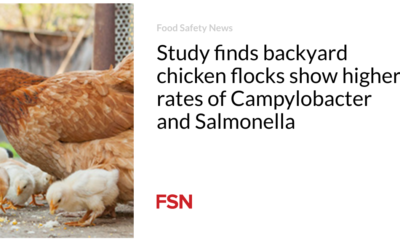Food
Waitrose points to ‘external factors’ for high Campylobacter results

Supermarket chain Waitrose blamed factors beyond the control of the retailer and its suppliers for poor Campylobacter results in chicken.
The Food Standards Agency’s (FSA) maximum target level is a maximum of 7 percent of birds with more than 1,000 colony-forming units per gram (CFU/g) of Campylobacter.
Waitrose and Partners reported that 7.1 percent of chickens tested positive for Campylobacter above 1,000 CFU/g between October and December 2023.
“This is unusually high compared to our previous results, but levels of Campylobacter can be adversely affected by seasonal changes and local weather conditions, such as unusually damp or foggy conditions, which are beyond the control of Waitrose and Partners and its suppliers. ‘, said the shopkeeper.
“Waitrose and Partners and its suppliers take any result above 1,000 CFU/g seriously, and our suppliers fully investigate everything to ensure that all verifiable parameters are within agreed specifications.”
The results from Waitrose and Partners show that 2 percent of samples tested positive for Campylobacter at levels above 1,000 CFU/g from July to September and April to June.
Sainsbury’s, Aldi and Coop
Data from retailers covers the second half of 2023 on high findings of Campylobacter in fresh, store-bought, UK-produced chicken.
The Sainsbury’s chain has joined retailer Tesco to stop publishing related data.
“The safety of our products is extremely important to us and we have implemented a range of processes to monitor and limit the levels of Campylobacter in our fresh chicken. We have consistently achieved the FSA target for Campylobacter levels for a number of years, so we will no longer formally report on this,” a Sainsbury’s spokesperson said.
Sainsbury’s Campylobacter results for the second quarter of 2023 showed 1 percent of chickens had levels above 1,000 CFU/g, compared to 3 percent in the first quarter.
Aldi did not update its web page or provide the figures when Food Safety News requested them. The latest data from the fourth quarter of 2022 show that 1.7 percent of chickens had a content above 1,000 cfu/g.
Co-op reported chickens contaminated at levels above 1,000 cfu/g for the first time since the third quarter of 2021. In the third quarter of 2023, 3.5 percent was above 1,000 cfu/g; in the fourth quarter this was 2.6 percent.
Results from other supermarkets
Lidl registered 4 percent of birds in the highest category from July to September and more than 2 percent from October to December 2023. In the highest category, the figures from April to June were almost 2 percent and from January to March 4 percent.
Marks and Spencer had 1 per cent of samples in the highest threshold in July, none in August and 4 per cent in September from 376 samples. The retailer also had 3 percent above 1,000 CFU/g in October, none in November and 3.85 percent in December.
Marks and Spencer had no top level samples from April to June. It also had none above 1,000 CFU/g in January and 1 percent each in February and March 2023 from 376 samples.
Asda reported that 2.42 percent of samples contained more than 1,000 cfu/g in the third quarter of 2023 and 3.33 percent in the fourth quarter. This compared to 3.6 percent in the first quarter and 3.5 percent in the second quarter.
Morrisons had no chickens contaminated at more than 1,000 cfu/g in either quarter, compared to 2.3 per cent from April to June and 2.4 per cent from January to March 2023.
Irish situation
In other news, details have been shared Zoonoses and public health on a Campylobacter monitoring program in Ireland and test results between 2019 and 2022.
In 2015, the Campylobacter Stakeholders’ Group was established to reduce contamination in Irish broiler flocks.
An analysis of data from 2019 to 2022 showed a significant decrease in concentrations in both the caeca and neck skin when the 2022 results were compared to those from 2019 and 2020. Campylobacter was found in 37 percent of cecal samples from broilers fed were emptied for the first time (pre-thin) and 30 percent of the neck skin samples in 2022, while in 2022 only 4 percent of the neck skin samples came from carcasses with levels above 1,000 cfu/g.
Researchers say collaboration between broiler chicken industry stakeholders and regulators has enabled a coordinated approach to monitoring Campylobacter levels and implementing control measures. This has allowed a steady reduction of the pathogen in chickens.
(To sign up for a free subscription to Food Safety News, click here.)











